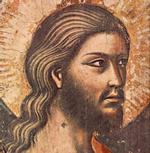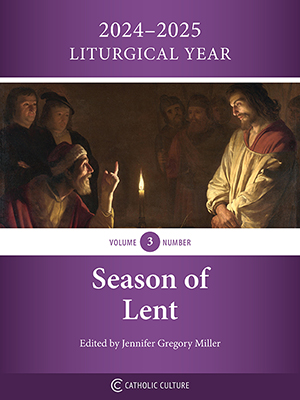Blessed Fra Angelico
by L. C. Schotl
Fra Giovanni Angelico da Fiesole was born Guido di Pietro, in the Tuscan area of Mugello, near Fiesole, towards the end of the 14th century. A Dominican friar and Italian Renaissance painter, he began his career as an illuminator of missals and other religious books. San Marco in Florence holds some choral books illuminated by his hand and said to be so beautiful that words cannot describe them.
Guido entered a Dominican convent in Fiesole in 1418 and became a friar using the name Fra Giovanni da Fiesole, following the custom of those in Holy Orders of taking a new name. Fiesole is sometimes misinterpreted as being part of his formal name, but it was merely the name of the town where he took his vows, used by his contemporaries to separate him from other Fra Giovannis. He was a member of the Observant Branch of the Dominican Order at Fiesole.
In 1436, Fra Giovanni was one of a number of Dominican friars of Fiesole who moved to the newly built convent of San Marco in Florence. Fra Giovanni, sometimes aided by assistants, set about the task of decorating the monastery, including many frescoes for the cloister, chapter house, and entrances to the 20 cells on the upper corridors. The most impressive of these are the: Crucifixion, Transfiguration, and the often-reproduced Annunciation, at the top of the stairs to the cells.
In 1439, he completed one of his most famous works: the altarpiece for St. Marco's, Florence. The result was atypical for the time. Images of the enthroned Madonna and Child surrounded by saints were common, but they usually depicted a setting that was clearly heavenlike, in which saints and angels hovered about as divine presences rather than people. But in this particular piece, the saints stand within the same spatial setting, in a natural way as if they appear to be conversing with one another about the shared experience of witnessing the Virgin in glory. Paintings such as this, known as Sacred Conversations (sacra conversazione), were to become the major commissions of Giovanni Bellini, Perugino and Raphael. He painted numerous altarpieces as well as frescos, several outstanding examples being in the San Marco convent, now a museum of the paintings and frescoes of Fra Angelico and other friars.
Additional important early works are Madonna of the Star, Christ in Glory, and Coronation of the Virgin; this latter is said to be superior to all the other works because of how well and delicate the multitude of saints and their expressions were painted. Vasari expressed that it was so ethereal, and that the whole coloring of the work was so beautiful, that it appeared to be created by the hand of a saint or an angel, it was with good reason the monk was called Fra Giovanni Angelico.
Giorgio Vasari, an Italian painter and architect, known for his famous biographies of Italian artists, popularized the use of the name Angelico for him, but says it is the name by which he was always known, and was certainly used as early as 1469. Vasari referred to Fra Giovanni, already known as Fra Giovanni Angelico (Brother Giovanni the Angelic One) as "a man of great simplicity, and most holy in his ways." Vasari also noted that Fra Giovanni was continuously laboring at his painting, and would paint only holy subjects. It was averred that he never handled a brush without a prayer, and wept when painting a crucifix. In Italy, the painter had long been called "il Beato Angelico" (the Blessed Angelico).
Fra Giovanni Angelico led a holy and self-denying life; he shunned advancement and was a brother to the poor. It was said that no man ever saw him angered. In 1455, at the age of sixty-eight, Fra Angelico died in Rome at a Dominican Convent and was buried by his fellow friars in the church of Santa Maria sopra Minerva, where his marble tombstone still exists.
NON MINI SIT LAUDI, QUOD ERAM VELUT ALTER APELLES, SED QUOD LUCRA TUIS OMNIA, CHRISTE, DABAM; ALTERA NAM TERRIS OPERA EXTANT, ALTERA COLOE; URBS ME JOANNEM FLOS TULIT ETRURAE.
This Latin epitaph on Fra Angelico's tomb was composed by Pope Nicholas V and is translated as:
GIVE ME NOT PRAISE FOR BEING ANOTHER APELLES, BUT THAT I GAVE ALL I HAD TO THY POOR, O CHRIST; THUS PART OF MY WORK REMAINS ON EARTH AND PART IN HEAVEN; THAT CITY WHICH IS THE FLOWER OF ETRURIA BORE ME, GIOVANNI.
Fra Angelico was beatified by Pope John Paul II in 1984. The Pope said, "Angelico was reported to say, 'He who does Christ's work must stay with Christ always.' This motto earned him the epithet Blessed Angelico, because of the perfect integrity of his life and the almost divine beauty of the images he painted, to the superlative extent those of the Blessed Virgin Mary."
Sources:
Giorgio Vasari, trans. George Bull. Lives of the Artists. New York: Penguin Books, 1965.
William Michael Rosetti. "Angelico, Fra," Encyclopedia Britannica Eleventh Edition. Encyclopaedia Britannica Inc., 1911.
J.B. Supino, trans. Leader Scott. Fra Angelico. Florence: Alinari Brothers, Publishers, 1902.
© Apostolic Publishing
This item 8189 digitally provided courtesy of CatholicCulture.org






